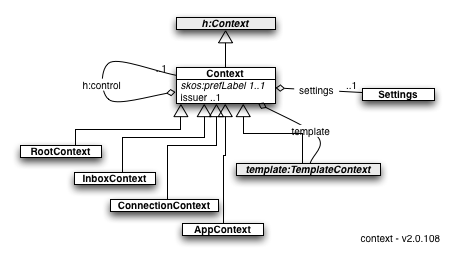Notice: this Wiki will be going read only early in 2024 and edits will no longer be possible. Please see: https://gitlab.eclipse.org/eclipsefdn/helpdesk/-/wikis/Wiki-shutdown-plan for the plan.
Difference between revisions of "Context vocabulary"
(→Context) |
(→Links) |
||
| (2 intermediate revisions by the same user not shown) | |||
| Line 7: | Line 7: | ||
==UML Overview== | ==UML Overview== | ||
| − | [[Image:Context 2.0. | + | [[Image:Context 2.0.108.png|center]] |
==Classes== | ==Classes== | ||
===Context=== | ===Context=== | ||
| − | A context as used in the Persona data model | + | A context as used in the Persona data model. A container of a set of entities. Contexts are usually created using information from a special kind of context called a template:TemplateContext. The template:TemplateContext contains a ContextPrototype that describes the context to be created. Regular contexts have a ''template'' attribute that its the TemplateContext that originally defined it. |
* subClassOf: h:Context | * subClassOf: h:Context | ||
* 0..1 h:control | * 0..1 h:control | ||
| Line 19: | Line 19: | ||
* 0..1 settings | * 0..1 settings | ||
* 1..1 skos:prefLabel | * 1..1 skos:prefLabel | ||
| + | |||
| + | ===AppContext=== | ||
| + | A context that provides storage for an add-on app to the portal, a built-in app-like functionality in the portal (e.g. the all-about-me editor app), or an HBX add-on (e.g. dynamically loaded JavaScript app). | ||
| + | * subClassOf: h:Context | ||
===InboxContext=== | ===InboxContext=== | ||
| Line 66: | Line 70: | ||
== Links == | == Links == | ||
* [[Persona Data Model 2.0]] | * [[Persona Data Model 2.0]] | ||
| − | |||
[[Category:Higgins 2 Vocabularies]] | [[Category:Higgins 2 Vocabularies]] | ||
Latest revision as of 20:50, 11 October 2011
{{#eclipseproject:technology.higgins|eclipse_custom_style.css}}
A vocabulary to describe contexts. Imported by Persona vocabulary.
Contents
Files
- SVN source: context.owl
UML Overview
Classes
Context
A context as used in the Persona data model. A container of a set of entities. Contexts are usually created using information from a special kind of context called a template:TemplateContext. The template:TemplateContext contains a ContextPrototype that describes the context to be created. Regular contexts have a template attribute that its the TemplateContext that originally defined it.
- subClassOf: h:Context
- 0..1 h:control
- 0..1 issuer
- 0..1 template
- 0..1 settings
- 1..1 skos:prefLabel
AppContext
A context that provides storage for an add-on app to the portal, a built-in app-like functionality in the portal (e.g. the all-about-me editor app), or an HBX add-on (e.g. dynamically loaded JavaScript app).
- subClassOf: h:Context
InboxContext
Special "inbox" context that is used to receive notifications from other ADS user accounts. Only one inbox context per ADS user.
- subClassOf: h:Context
RootContext
A tagging subclass indicating that this context is the "root" context for this user. There should only be one instance of RootContext for each user.
- subClassOf: Context
Settings
A class to hold setting information for the containing context. Settings are the user's preferences for how to interact with the containing context, as opposed to pure data held by the context. It is expected that contexts that have specific settings will attach them as attributes to an instance of Settings (or some subclass thereof).
- subClassOf: owl:Thing
Attributes
issuer
The entity (e.g. a business) that defines this context: defines the schema used, defines the meaning of the attributes of the schema, defines the interaction context withing which these attributes gain values. The issuer is often, but not necessarily the entity that makes the attribute value assertions (claims). If the issuer is Equifax, then indeed Equifax is making the claim that the "bearer" of this context is, say, over 21 years of age. As a counter example, the issuer of a context might be Facebook. In this case the values are asserted by the Facebook user, yet Facebook is considered the issuer. This is a required attribute of all Contexts.
- domain: Context
- value: URI. The URI is either the domain name that is the authority behind the attribute assertions or
- The value
http://!self- the user has explicitly asserted entities & attributes in this context - The value
http://!derived- the active client has derived entities & attributes in this context based on observed behavior and/or assertions made by the user in other contexts
- The value
settings
A singleton instance of the Settings class.
- domain: Context
- value: Settings
template
A link to a TemplateContext that acts as a template for this context.
- domain: Context
- value: template:TemplateContext
Attributes from higgins.owl
Repeated here for convenience.
h:control
Inherited from h:Context. See Higgins Data Model 2.0.
- domain: Context
- value: h:Context
h:vocabulary
Inherited from h:Context. See Higgins Data Model 2.0.
- domain: h:Context
- range: owl:Ontology

